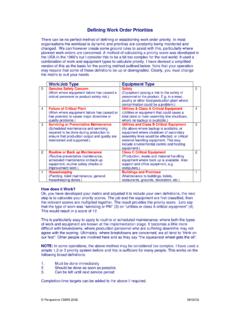Transcription of Hazard identification risk assessment and control
1 HIRAC plan template available: Hazard identification RISK assessment AND control Department of Health and Safety Services 2017 Hazard identification , Risk assessment and control Revision of: New Date of Issue: September 2017 1 Contents 1. Introduction .. 2 2. Purpose .. 2 3. Scope .. 2 4. VIU Health and Safety Policy .. 2 5. Responsibilities for this program .. 2 6. Regulatory and best practice requirements .. 4 7. Program specifications and procedures .. 4 Step 1 Hazard identification .. 0 Step 2 Risk assessment .. 0 Step 3 Hazard Controls .. 3 Step 4 Implement selected Hazard controls .. 5 Step 5 Assess effectiveness of selected controls.
2 5 8. Training and education requirements .. 6 9. Tools and resources available to the viu community .. 6 Hazard identification , Risk assessment and control Revision of: New Date of Issue: September 2017 2 1 . INTROD UCTION Hazard identification , risk assessment , and control are the starting points of all preventive efforts in VIU s Health and Safety Program. Hazard identification , and the subsequent risk assessment and corrective actions, is completed to minimize the hazards associated with work activities. Risk assessment and Hazard controls will provide the basis for the requirements needed to ensure a safe work place.
3 Because hazards can change, and process change can create new hazards, risk assessment will require continuous evaluation. 2 . P URP OSE The purpose of this program manual is to describe the requirements and procedures established by VIU to identify hazards and to assess and control risk in the workplace thereby ensuring that all VIU employees work in the safest manner possible. This program applies to all VIU employees (faculty and staff) and students who perform work and may be exposed to hazards in the workplace. 3 . SCOP E This Health and Safety program deals specifically with the identification , assessment and control of hazards that may be encountered while performing work at or on behalf of VIU. 4. VIU HEAL TH AND SA F ETY P OL ICY 4 1 .0 9 Vancouver Island University is committed to promoting a safe and healthy working and learning environment.
4 It is the priority of the University to ensure safe working conditions and job safety practices in the planning, budgeting, direction and implementation of the University s activities. 5 . RESP ONSIB IL ITIES FO R THIS P ROGRAM At VIU, everyone has a responsibility for safety. In BC, the Workers Compensation Act identifies the health and safety responsibilities of the employer, supervisors, and workers. Hazard identification , Risk assessment and control Revision of: New Date of Issue: September 2017 3 VIU The employer, represented by the senior management group at VIU, has the greatest responsibilities with respect to health and safety in the workplace and is responsible for taking every precaution reasonable for the protection of a worker.
5 The employer must ensure that formal Hazard identification process is undertaken. To assist with these responsibilities, VIU has delegated the administrative oversight of the VIU Health and Safety Program to the Department of Health and Safety Services. Health and Safety Services (H&SS) H&SS provides the co-ordination, technical expertise and administrative oversight for the VIU Hazard identification , Risk assessment and control Program. H&SS will: 1) Develop, implement, manage and maintain the VIU health and safety program and its related procedures; 2) Educate, train, and create tools and resources for the VIU campus community to support implementation of the program and procedures; 3) Assist departments/faculties with their Hazard identification and risk assessment requirements. Administrative Heads (Deans, Executive Directors, campus administrators) Administrative heads will: 1) Ensure that supervisors, faculty (instructors and technicians) and staff in their respective areas are aware of the VIU Hazard identification , assessment and control Program.
6 2) Ensure that appropriate training in Hazard assessment is made available to the faculty and staff in their respective areas. 3) Ensure that faculty and staff know their responsibilities for Hazard assessment and document and complete them when required. Supervisors A supervisor is a person who instructs, directs and controls workers (and/or students) in the performance of their duties Supervisors are responsible for making workers fully aware of the hazards that may be encountered on the job or in the workplace; ensuring that they work safely and respond to any of the hazards brought to their attention, including taking every precaution reasonable in the circumstances for the protection of a worker. Supervisors will: 1) Ensure that workers in their respective areas are aware of the VIU Hazard identification , risk assessment and control program.
7 2) Ensure that appropriate training in Hazard identification and risk assessment is made available to the faculty and staff in their respective areas. 3) Ensure that faculty and staff know their responsibilities for Hazard identification and risk assessment and complete them when required. 4) Ensure that controls are implemented and available ( PPE). 5) Retain Hazard identification and risk assessment records. 6) Eliminate or minimize exposure to all hazards. 7) Provide and maintain the equipment required to control any Hazard and ensure that the workers use the equipment when required. Faculty and Staff (workers) Worker responsibilities include: Hazard identification , Risk assessment and control Revision of: New Date of Issue: September 2017 4 1) Review the Hazard identification , risk assessment and control program.
8 2) Attend required training and orientation sessions. 3) Discuss concerns with their supervisor and when necessary Health and Safety Services. 4) Report any hazards that could lead to unsafe conditions to their supervisor to ensure that corrective actions are taken without delay. Joint Occupational Health and Safety Committee 1) Support and promote implementation of the Hazard identification , risk assessment program and related training. 2) Participate in formal inspections to assist in Hazard identification and recommend corrective action. Local Health and Safety Committee 1) Participate in formal inspections to assist in Hazard identification and recommend corrective action. 6. REGUL ATORY AND BE ST P RACTICE REQUIRE M ENTS BC Workers Compensation Act, Part 3, Section 115 (General duties of employers), 116 (General duties of workers), 117 (General duties of Supervisors) WorkSafeBC Regulation, Part 3 Workplace Inspections ( ) WorkSafeBC Regulation, Part 6, 7, 9, 32 7.
9 P ROGRAM SP ECIFICA TIONS A ND P ROCED URES A Hazard identification , Risk assessment and control (HIRAC) Plan must be completed by the person performing the work and their supervisor before any new or modified equipment, machinery or work process is used or started. A HIRAC Plan must be reviewed at least annually and whenever there is a change in operations or procedures or there has been an incident involving work or processes previously assessed in a HIRAC plan. There are five different steps involved in a HIRAC plan. These steps are tracked on the HIRAC Plan form. Each step is outlined in this section. The HIRAC Plan template can be found in Appendix 1. HIRAC plan template available: Step 1 Hazard identification Accurately identifying potential hazards in the workplace is the first step in developing a HIRAC.
10 Conduct a work site inspection and observe how work tasks are performed, assess equipment workers are using, and analyze the design and layout of the work area. Consider non-routine operations, such as maintenance , cleaning operations, or changes in work cycles. All the processes and situations that could possibly harm workers, students, or visitors that may be on campus must be considered. Hazards can be identified by reviewing manufacturers manuals, safety data sheets, and work site inspections, as well as conducting worker interviews and reviewing incidents in the workplace or similar work areas. Other common hazards include exposure to chemicals, biological agents (bacteria, viruses, mould), biohazardous materials, motorized equipment, energized equipment, extreme temperatures, noise, vibration, violence work design (poor ergonomics), working alone, cash handling, and theft.

